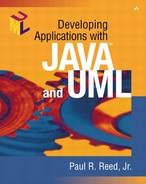IN THIS CHAPTER
As mentioned in Chapter 1, to be successful in today's ever-changing business climate, software development must follow an approach that is different from the big-bang approach. The big-bang approach, or waterfall model, offers little risk aversion or support for modification of requirements during development. The waterfall model forces the project team to accept insurmountable risks and create software that usually doesn't approximate the original vision of the project sponsors.
This chapter looks at Java as an enterprise solution for constructing and implementing industrial-strength applications that will better approximate what the sponsors intended. Java is a language that not only supports object-oriented concepts, but also formally acknowledges many constructs not formally found in other object languages, such as the interface. This chapter explores Java's object strengths.
The UML is object-oriented, and its diagrams lend themselves to being implemented in software that is object-oriented. This chapter examines how UML, coupled with a sound software process model, such as the Unified Process, can produce applications that not only meet the project sponsor's goals, but also are adaptive to the ever-changing needs of the business.
